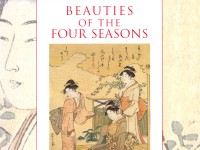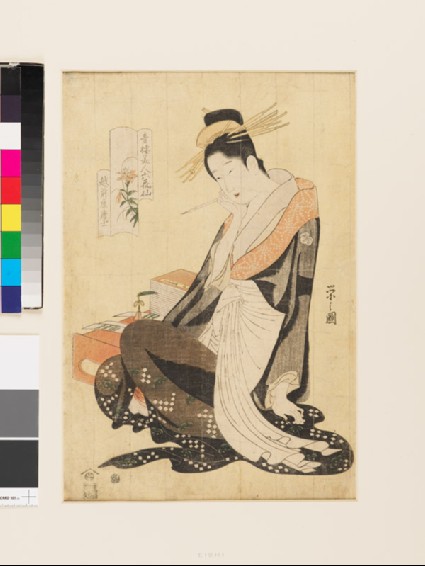Beauties of the Four Seasons
A full catalogue of the Ashmolean’s collection of Japanese bijinga (beautiful women) prints by Mitsuko Watanabe (published Oxford, 2005).

Publications online: 54 objects
- Reference URL
Actions
The Courtesan Morokoshi of Echizen-ya
-
Literature notes
This series is very loosely based on the six greatest poets of the ninth century. The courtesan Morokoshi was enrolled in the Echizen-ya between 1791 and 1799, and she was sometimes depicted by Eishi and Utamaro even though she was not of the highest rank of the courtesan. Morokoshi was famous as a poet and in this print she is holding a writing brush, thoughtfully contemplating her poem. She is wearing a black summer kimono with green pine tree design. Her obi shows a white decorative design using gauffrage and her collar has an applied coating of mica on the yellow ground. The label of the series and title is on the top of the left side and includes a red lily. -
Details
- Series
- The Six Poetic Beauties of the Green Houses
- Associated place
- Date
- c. 1794 - c. 1795
- Artist/maker
-
Hosoda Eishi (1756 - 1829) (designer)
- Associated people
-
Nishimuraya Yohachi (c. 1751 - c. 1870) (publisher)Morokoshi of Echizen-ya (active c. 1800) (subject)
- Material and technique
- nishiki-e (multi-block) woodblock print, with gauffrage, printed with water-based vegetable pigments and mica
- Dimensions
-
mount 55.5 x 40.1 cm (height x width)
print 36.2 x 24.8 cm (height x width)
- Material index
- Technique index
- Object type index
- No. of items
- 1
- Credit line
- Purchased, 1970.
- Accession no.
- EA1970.111
-
Further reading
Oxford: Ashmolean Museum, 24 August-30 November 2005, Beauties of the Four Seasons, Mitsuko Watanabe, ed. (Oxford: Ashmolean Museum, 2005), no. 20 on p. 40, illus. p. 41
Glossary (3)
gauffrage, nishiki-e, vegetable pigments
-
gauffrage
Decorative embossing technique. In Japanese prints, it is also sometimes called 'blind printing'.
-
nishiki-e
Nishiki-e literally means 'brocade pictures' and refers to multi-coloured woodblock prints.
-
vegetable pigments
Vegetable pigments were used to create coloured dyes for Japanese prints, paintings, and textiles. These pigments often faded over time due to the chemical reactions they underwent.
Location
-
- currently in research collection
Objects are sometimes moved to a different location. Our object location data is usually updated on a monthly basis. Contact the Jameel Study Centre if you are planning to visit the museum to see a particular object on display, or would like to arrange an appointment to see an object in our reserve collections.
Publications online
-

Beauties of the Four Seasons
This series is very loosely based on the six greatest poets of the ninth century. The courtesan Morokoshi was enrolled in the Echizen-ya between 1791 and 1799, and she was sometimes depicted by Eishi and Utamaro even though she was not of the highest rank of the courtesan. Morokoshi was famous as a poet and in this print she is holding a writing brush, thoughtfully contemplating her poem. She is wearing a black summer kimono with green pine tree design. Her obi shows a white decorative design using gauffrage and her collar has an applied coating of mica on the yellow ground. The label of the series and title is on the top of the left side and includes a red lily.
Notice
Object information may not accurately reflect the actual contents of the original publication, since our online objects contain current information held in our collections database. Click on 'buy this publication' to purchase printed versions of our online publications, where available, or contact the Jameel Study Centre to arrange access to books on our collections that are now out of print.
© 2013 University of Oxford - Ashmolean Museum

